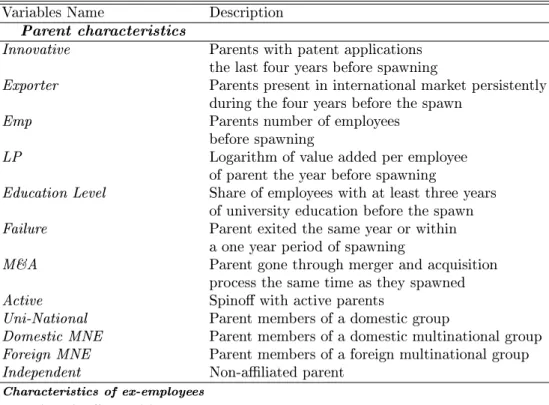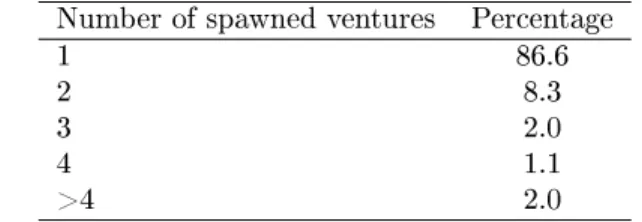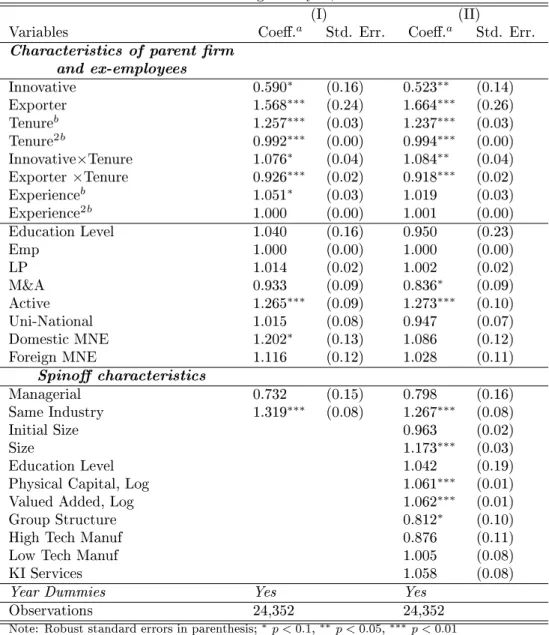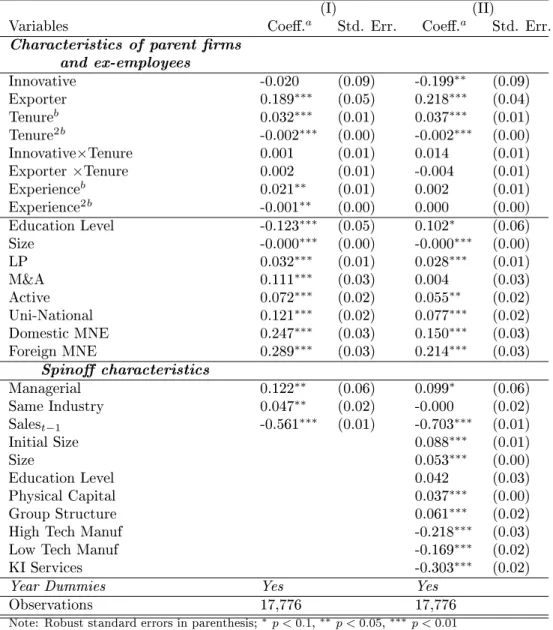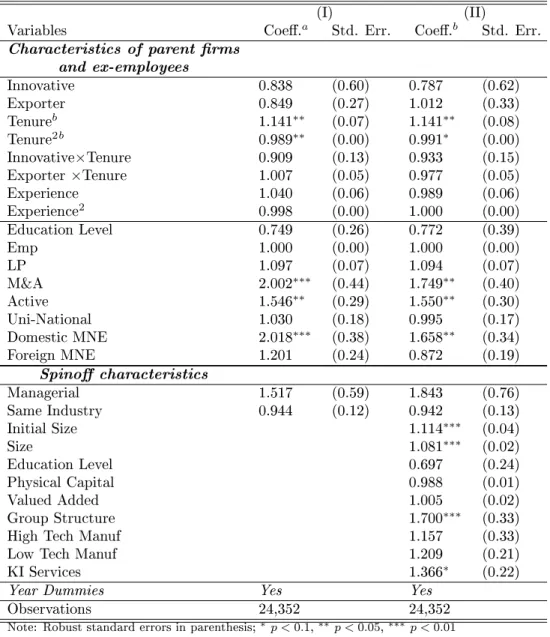This suggests that inherited advantages in this case are not primarily driven by enhanced opportunities for on-the-job learning. Direct empirical tests of workplace learning as a key mechanism of organizational legacy are largely lacking. Possibilities for learning at the workplace using technologically innovative rms and exporting rms, respectively, are discussed.
Although not explicitly discussed in the context of this study, we note that different types of indirect relationships between technological innovation and opportunities for workplace learning opportunities are possible. As mentioned above, Agarwal et al. 2004), on the other hand, report evidence supporting the existence of such a relationship from their study of the same industry. Based on explanations for organizational heritage based on different types of on-the-job learning and network development, a longer tenure in an established firm would appear to imply a stronger legacy.
In particular, it provides a test of widely held views of workplace learning and networking as a key mechanism of organizational succession.
Data and sample
Third, to have sufficient information on both parent farms and their offspring, we limit the analysis to seven cohorts to follow original owners for the last four years before spawning and new farms over a five-year period. The first cohort consists of spino companies in 2001, and the last cohort of spino companies entered the market in 2007. In addition, we exclude spino companies entering the primary sectors (agriculture, fisheries and extraction; NACE 1-14) and the hotel and restaurant sector ( NACE 55), as the patterns of entry and survival in these sectors are not similar to those in the rest of the economy.
It should be noted that, unlike some previous studies, we do not restrict spino negation to rms that are produced in the same industry as the parent rm. However, in the regression analysis, we use the information whether the new RM operates in the same industry with figures as the parent company. The usage data consists of 5,688 unique spinos that entered the market during the period 2001-2007 and have about 70% survival after five years, as illustrated in Table 1.
It is worth noting that only 2% of incumbent rms have more than four entrepreneurial spawns during this seven-year period (Table 2).

Variables
The variable tenure is deposited as the average years of tenure in older rms. This measure will help us to answer the question How does the length of employment tenure in the parent rm affect the success of spawns. As with the measure of total experience, the variable is calculated using information on only those employees who leave the incumbent rm identified as the parent.
The control variables are related to the characteristics of both the incumbent rms and their spinos. There is broad agreement in the entrepreneurship literature that human capital is a key asset for new ventures. This variable captures the general labor market experience of spinos employees, while the employment in parent variable reflects only the relative knowledge specific to the incumbent identified as the parent.
Education and experience, as represented by these three variables, are associated in the entrepreneurship literature with entrepreneurial and management competencies (e.g., however, these temporary exporters account for only 2 percent of the total value of Swedish exports.
Therefore, we include controls for the parent firm's physical capital and productivity in both firm categories (labor productivity in the existing firm and value added in the new firm). We also control for the size of the parent RM in terms of the total number of employees, before spawning, and the initial number of employees of the new entrant. Therefore, three distinctions were made according to the activity of the parent company: first, established entities that continue to be active on the labor market, active; secondly, the original operators who exited in the same year or during the one-year spawning period, Failure.
Summary statistics
This should be associated with a higher quality of spinos at entry, as well as an increased tendency to abandon entrepreneurship if the new venture does not go as planned. Previous literature has identified that the size, productivity and success of the original staff are related to spina performance (Andersson and Klepper, 2013; Phillips, 2002; Dick et al., 2013; Fackler et al., 2015). Eriksson and Moritz Kuhn (2006), Dahl and Reichstein (2007) and Andersson and Klepper (2013) showed that, in accordance with the view of performance heterogeneity in connection with differences in opportunity costs before the establishment of a spino, survival is higher in the so-called pulled spinos than for pushed spinos.
Finally, the variable M&A dichotomously identifies those incumbents that were going through a merger or acquisition process at the same time as the launch of spino. Consistent with findings from other countries, a substantial portion of the new rms are entering the same market as their parents. It is noteworthy that new entrants exiting through the M&A process tend to be spawned by larger rms than other entrants.
Less than 20% of ex-employee startups can be considered push-driven as the incumbent rm disappeared from the market after spawning. As for the new ventures, they are all independent initially and more than 90% remain independent.

Main results
Whether this reflects inherited knowledge of processes, routines and other internal activities of the parent company (Helfat and Lieberman, 2002), access to similar international networks and market alternatives as the established rm, or differences in the entrepreneurial competence of the workforce of exporters, the new venture benefits of export experience. While the estimates for tenure show positive effects (1.175 and 1.131) and highly significant, the employment squared coefficients show diminishing returns to experience, as expected. Since the founders' overall labor market experience does not significantly affect spino survival (rows 7 and 8), these results can be interpreted as indicating that the abilities of the entrepreneurs' offspring were significantly shaped by experiences gained at the previous employer.
However, this eect is somewhat weaker for employment with exporting rms than for employment with non-exporters (row 6). Employee-entrepreneurs in the same ve-digit industry as the established firm are almost 15% more likely to survive than firms founded outside the industry. While previous registry-based studies suggest that parent size negatively predicts the performance of offspring Sorensen and Phillips (2011), and several studies report that more prominent rms beget better performing rms, Table 4 reports that the effect of parental size, education level and labor productivity is negligible.
The estimated results on the spino-covariates are presented in the lower part of table 4. The odds ratios show that spino survival chances increase with the added value, the physical capital and the size of the new rm. The estimated effect of key variables is almost the same as the results on survival presented above.
Table A.5 in the appendix shows the M&A exit probabilities compared to failure. However, results on inheritance in the upper part of the table show some interesting differences. An interesting result from Table A.5 is the positive association between a parent with an M&A background and the likelihood of M&A from the rm generated.
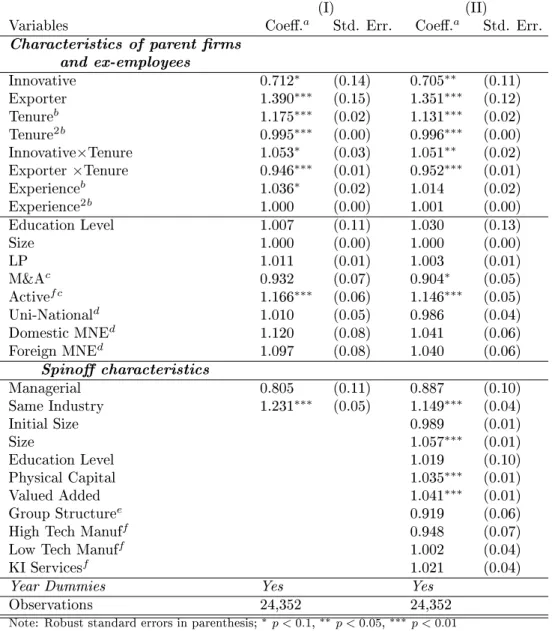
Robustness and extensions
We use the same control variables as in the survival regression and, following the previous literature (Delmar et al., 2013), also control for the previous sales. We find that some control variables related to the performance of the parent rm (group status, productivity) and to the scale of the spin-o (initial size, group status) unrelated to survival do predict rm growth. Thus, we ask, which of the mechanisms of organizational inheritance outlined in section three will also produce increased opportunity costs of entrepreneurship in spin-o ventures.
By addressing these questions, this paper delineates theoretical arguments for organizational heritage in relation to differences in opportunities for learning; in the opportunity costs of entrepreneurship; and in ability sorting between (different categories of) rms. These relationships are empirically analyzed using data on the entire Swedish private sector in the period 1997-2011. Information about the former employees' position and employment in the parent company and their overall experience on the labor market is also used.
This latter result is clearly in line with the dominant notion in the literature of greater opportunities to learn and accumulate resources while working for larger business entities. While employment in the parent company is positively associated with spino survival, this effect is actually found to be less—not more—pronounced when employed in the exporting company. None of these views on organizational heritage would imply that a longer tenure in an exporting company is not associated with either better or worse spino performance.4.
Productivity and turnover in the export market: micro-level evidence from the Republic of Korea and Taiwan (China). Evolution on the shoulders of giants: entrepreneurship and corporate survival in the German laser industry. Disagreements, Spinos, and the Evolution of Detroit as the Capital of the American Auto Industry.
The role of fixed capabilities in the evolution of the laser industry: creating a high-tech market. Management share of employees of the spino holding a management position in the established parent Same industry Spino working in the same ve figure.
